Click on the following image for better readability. This image shows position and phase of moon at sunset till Full moon.
http://www.moonrealestate.com.au/phases_of_the_moon.htm
PHASES OF THE MOON
Did you know?
The lunar cycle takes 29.5 days to go from full moon to full moon.
In between there is the "New Moon" which we cannot see.
Shortly after New Moon, we see a thin crescent Moon in the west shortly after sunset (refer image to left of this paragraph > top left-most Moon image).
As the days go on, this crescent becomes thicker, and thicker.
About seven days after New Moon, the Moon appears as a half-circle (the seventh image in the sequence). This phase is called "first quarter".
The Moon continues getting fuller, and fuller, until 14.75 days after New Moon, when "Full Moon" occurs.
After full moon the disk shrinks back towards a half-illuminated phase ("last quarter"), and then continues to shrink into a crescent that rises shortly before the Sun in the eastern sky.
The lunar cycle takes 29.5 days to go from full moon to full moon.
In between there is the "New Moon" which we cannot see.
Shortly after New Moon, we see a thin crescent Moon in the west shortly after sunset (refer image to left of this paragraph > top left-most Moon image).
As the days go on, this crescent becomes thicker, and thicker.
About seven days after New Moon, the Moon appears as a half-circle (the seventh image in the sequence). This phase is called "first quarter".
The Moon continues getting fuller, and fuller, until 14.75 days after New Moon, when "Full Moon" occurs.
After full moon the disk shrinks back towards a half-illuminated phase ("last quarter"), and then continues to shrink into a crescent that rises shortly before the Sun in the eastern sky.
http://10minuteastronomy.wordpress.com/2009/08/26/extended-mission-follow-the-moon/
Imagine that you are standing in an open field at sunset, facing south (better yet, arrange to be in an open field at sunset, facing south!). If it just a couple of days after the new moon, this is what you’ll see:
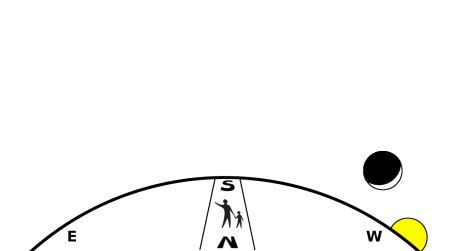
In the diagram above, showing a young crescent moon, the moon has not yet moved very far from the sun; in fact, is still very far sun-ward of the Earth. Most of the sunlight is falling on the far side of the moon, but the moon is enough off to one side of the Earth-Sun line that a little light spills over to the near side.
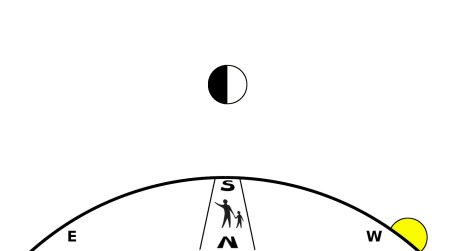
The next night the moon will rise about an hour later and be about 13 degrees farther from the sun in the sky. From being in between the Earth and Sun, the moon is moving around to be beside the Earth, relative to the sun. When it gets there, then it will be halfway up the sky at sunset, and halfway illuminated on the near side. This is the first quarter moon, and it’s absolutely the best time to haul out binoculars or a telescope and see the play of light and shadow over the craters, mountains, and valleys of la Lune.
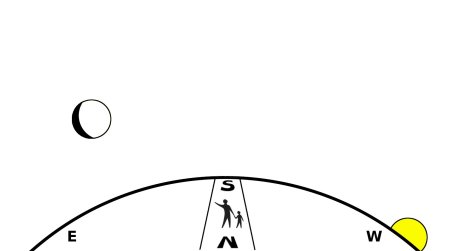
Once past first quarter, the moon continues to rise later and is consequently less far up the sky when the sun sets. But now the near face is turned more squarely to the sun and appears more fully lit. This more-than-half-lit condition is gibbous, and since the moon is getting fuller each night, it is a waxing gibbous moon.
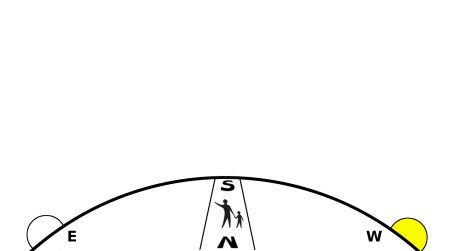
Eventually, about two weeks after new moon and one week after first quarter moon, the moon rises at the same time that the sun sets. The moon and sun are now precisely opposite each other in the sky, so the near face is entirely lit and the moon is full. Once in a while things line up so that the Earth is exactly between the sun and moon, and the shadow of the Earth on the moon creates a lunar eclipse. It should be obvious that a lunar eclipse can only occur at full moon.
That doesn’t mean that a lunar eclipse can only occur at sunset; the moon may become maximally full when it is halfway across the sky (and the sun is halfway between rising and setting), or during the day, or at any other time. Another way to think of it: whenever a lunar eclipse occurs, it will be at sunset for somebody, somewhere–and sunrise for someone else, and midnight for someone else, and noon for someone else.
Most months there is no eclipse, because the moon’s orbit describes a slightly different path in the sky than the Sun, and the moon passes over or under the sun from our vantage point. If everything was in perfect alignment, we’d have a lunar eclipse every full moon, and a solar eclipse every new moon.
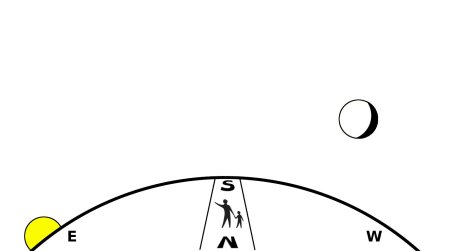
What happens after full moon? The moon continues to rise an hour later each night, but it has now gone past the point where it was opposite the sun in the sky (full moon), and starts to approach the sun from the other side. From our standpoint, it looks like the sun is catching up to the moon. From full moon to new moon the same phases pass–gibbous (mostly lit), quarter (half lit), crescent (less than half lit)–but in reverse order, and you have to stay up later and later to see them against a dark sky.
Eventually as the moon rises later and later, there comes a day when it rises at the same time as the Sun. In other words, the moon is now squarely between the Earth and Sun, the far side is entirely lit, the near side is entirely dark, and we can’t see the moon in the sky at all. This is the new moon, and in nights to come the moon will rise a bit later, trail the sun across the sky, and first be visible as a thin crescent low in the west at sunset, as in the first diagram up top. It should be obvious that a solar eclipse–when the moon gets squarely between the Earth and Sun, and the shadow of the moon falls on the Earth–can only happen at new moon.
You don’t always have to stay up late (or get up early) to see the waning phases. In a month, the moon spends just as much time in the daytime sky as it does in the nighttime sky. Think about it–at first quarter, the moon is at it highest point in the sky at sunset. Therefore it must have risen six hours earlier (1/4 of the way around the sky x 24 hours of sky rotation in a day = six hours), and been visible for most of the afternoon and early evening. Similarly, at last quarter, the moon is at the same point at sunrise; it rose in the middle of the night and won’t set until the middle of the day. The gibbous moons on either side of full are easiest to observe during daytime, because they’re bright enough to see easily. The crescent moons must necessarily be very close to the sun in the sky, and so they are up almost all day, having risen either just before the sun (waning crescent) or just after (waxing, as shown in the first diagram up top). But they are almost impossible to spot because they are so poorly lit (from our point of view); their feeble light is lost in the glare of the sun.
-------------------------------------------------------
http://www.astronomynotes.com/nakedeye/s13.htm
The table gives a summary of approximately when the Moon is visible and where to look (the crescent and gibbous phases are in between the table values). You may be surprised to find out that the Moon is sometimes visible in broad daylight!
Summary of Phase, Elongation, Moonrise and Moonset
http://www.astronomynotes.com/nakedeye/s13.htm
The table gives a summary of approximately when the Moon is visible and where to look (the crescent and gibbous phases are in between the table values). You may be surprised to find out that the Moon is sometimes visible in broad daylight!
| Phase | Time the Moon is ahead/behind the Sun | Moon Rises (eastern sky) | Moon Crosses Meridian (southern sky) | Moon Sets (western sky) |
|---|---|---|---|---|
| New | within few minutes | Sunrise | Noon | Sunset |
| First Quarter | 6 hrs behind | Noon | Sunset | Midnight |
| Full | 12 hrs behind | Sunset | Midnight | Sunrise |
| Third Quarter | 6 hrs ahead | Midnight | Sunrise | Noon |
Summary of Phase, Elongation, Moonrise and Moonset
| Phase | Elongation | Hr | Moonrise | Moonset | |
| New | 0 o | 0 | 6 | 18 | |
| Waxing Crescent | 15 o | 1 | 7 | 19 | |
| 30 o | 2 | 8 | 20 | ||
| 45 o | 3 | 9 | 21 | ||
| 60 o | 4 | 10 | 22 | ||
| 75 o | 5 | 11 | 23 | ||
| First Quarter | 90 o | 6 | 12 | 24 | |
| Waxing Gibbous | 105 o | 7 | 13 | 1 | |
| 120 o | 8 | 14 | 2 | ||
| 135 o | 9 | 15 | 3 | ||
| 150 o | 10 | 16 | 4 | ||
| 165 o | 11 | 17 | 5 | ||
| Full Moon | 180 o | 12 | 18 | 6 | |
| Waning Gibbous | 195 o | 13 | 19 | 7 | |
| 210 o | 14 | 20 | 8 | ||
| 225 o | 15 | 21 | 9 | ||
| 240 o | 16 | 22 | 10 | ||
| 255 o | 17 | 23 | 11 | ||
| Last Quarter | 270 o | 18 | 24 | 12 | |
| Waning Crescent | 285 o | 19 | 1 | 13 | |
| 300 o | 20 | 2 | 14 | ||
| 315 o | 21 | 3 | 15 | ||
| 330 o | 22 | 4 | 16 | ||
| 345 o | 23 | 5 | 17 | ||
| New | 360 o | 0 | 6 | 18 |









No comments:
Post a Comment
Comment Moderation is "OFF" in this blog. Your comment should appear soon after submission.
Do not attempt to type directly in the comment box. Type in text editor of your computer. Then copy paste here.That would be safe.